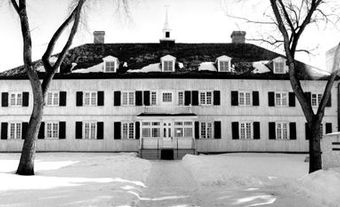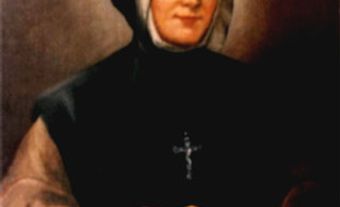Marie-Marguerite d'Youville, née Dufrost de Lajemmerais (born 15 October 1701 in Varennes, Quebec; died 23 December 1771 in Montreal). D'Youville was the founder of the Sisters of Charity of the Hôpital Général de Montréal, also known as the Grey Nuns. She was the first Canadian-born saint, canonized by Pope John Paul II in 1990.

Early Years: Family Life and Education under the Ursulines
Marguerite was born to parents Christophe Dufrost de Lajemmerais and Marie-Renée Gaultier de Varennes. Her father died when she was seven years old, leaving the family impoverished. Thanks to her maternal great-grandfather, Pierre Boucher de Boucherville (the former Governor of Trois-Rivières) Marguerite was able to travel to Quebec City and receive religious instruction from the Ursuline order, from around age 11 to 13. Upon her return to Varennes, Marguerite, who was the eldest of six children, undertook the education of her siblings and helped to support her widowed mother.
Did you know? Marguerite’s uncle was the famed explorer, military officer and fur trader Pierre Gaultier de Varennes et de La Vérendrye? At around the same time that Marguerite was beginning her professional charitable work in the 1730s, her uncle Pierre would have been charting Western Manitoba, and building posts from Lake Superior to Lake Winnipeg to promote the fur trade (see also Francophones of Manitoba).
Marriage of Marguerite’s Mother, Marie-Renée, to Timothée Sylvain
Around 1718 Timothy Sullivan, an Irish-born son of a doctor, arrived in New France as a captain in a regiment of dragoons, intent on starting a new life. He quickly integrated into his adopted homeland and gradually adopted a French version of his name, calling himself Timothée Sylvain. By 1720, the 24-year-old Timothée had wed Marguerite’s mother Marie-Renée, then widowed for over a decade and aged 38. The wedding took place in a parish church far from the family’s home in Varennes. In the context of the social conventions of the time, Marie-Renée was considered to have married below her class to a commoner, and this in turn prompted the annulment of Marguerite’s arranged marriage to nobleman Louis-Hector Piot de Langloiserie. The family would move to Montreal in 1721, and Marguerite would in turn marry François d’Youville there in 1722.
Marguerite’s Marriage to François d’Youville
Marguerite and François established a home together with François’ mother. François is said to have been an indifferent husband, more concerned with his business affairs than home life. He was rarely at home, and Marguerite had a difficult relationship with his mother. Complicating matters, though François was a fur-trader he was thought to also be involved in an illegal trade in alcohol with the local Indigenous population, which damaged the couple’s reputation. The couple would have six children, though four would die in infancy. François died in 1730. By the time she was aged 29, Marguerite had lost her father, husband and four of her own children. Marguerite’s two living children would later become priests.
Research by noted historian Marcel Trudel suggests that Marguerite d’Youville was likely a slaveowner. Though far from widespread, keeping slaves as domestic servants was a common practice amongst almost all levels of society in colonial-era Canada. It is unclear whether Marguerite owned her slaves or whether she inherited them from François d’Youville, and it is unknown whether she continued the practice during the time she experienced her religious renewal and founded her charitable enterprise.
A Religious Renewal, Dedication to a Life of Faith
Despite the many great difficulties in her young life, Marguerite maintained her involvement in various religious and charitable organizations, which commenced in 1727 when she was 26 years old. A profound religious awakening prompted her to dedicate her life to charity. On 31 December 1737 Marguerite and three colleagues formed an association to help the poor and opened a home to welcome them. This association, known as the Sisters of Charity, would evolve over time into the Grey Nuns.
Did you know?
The members of the Sisters of Charity were at times called les grises because of the d'Youvilles’ alleged profits from liquor trafficking. The French term can mean both “the greys” as well as “the tipsy.”
The Sisters of Charity
Initially, Marguerite’s efforts were directed at supporting women in dire need, as there were no facilities or services available at the time in Montreal. In 1747, the Grey Nuns were put in charge of the bankrupt Hôpital Général de Montréal, founded in 1692 by François Charon de La Barre (also known as the Charon Hospital). The institution evolved into a hospice for aged men and women, the disabled, foundlings, orphans and “fallen women,” among others. In 1750, civil and ecclesiastical authorities decided to unite it with the Hôpital Général de Québec, but the Sulpicians interceded in Paris, and on 3 June 1753 Louis XV gave the community legal status and title to the hospital. It is around this time that the Grey Nuns began wearing the grey habit that identified their community well into the 1960s.
In 1755 the women finally began their life as the Sisters of Charity of the Hôpital Général. They developed various enterprises including farms, an orchard, a mill and a bakery to finance their work. Though initially involved in the care of those who could not care for themselves, it was during the smallpox epidemic of 1755 and the Seven Years' War that their hospital became more of a comprehensive medical establishment. Though her hospital would burn to the ground in 1765 and Marguerite would pass away in 1771, the religious order she founded would continue to grow and take on important roles in the history of Montreal, Quebec and Canada.

The First Canadian-Born Saint
Many people attested to her prophetic gifts and miraculous healing powers. For example, a young woman stricken with acute myeloblastic leukaemia in 1978 claimed to have been miraculously cured through her intercession. Years after her death, her spirituality and sacrificial life were officially recognized by Rome. In 1959, Marie-Marguerite d’Youville was beatified by Pope John XXIII, and was later canonized by Pope John-Paul II in 1990, making her the first Canadian-born saint.
Did you know?
St. Marie-Marguerite d’Youville’s Catholic feast day is October 16.

 Share on Facebook
Share on Facebook Share on X
Share on X Share by Email
Share by Email Share on Google Classroom
Share on Google Classroom



